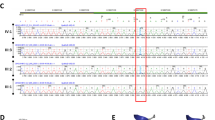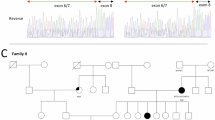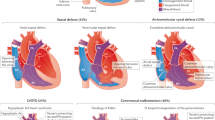Abstract
Congenital heart disease (CHD) is the most common type of birth defects with family- and population-based studies supporting a strong hereditary component. Multifactorial inheritance is the rule although a growing number of Mendelian forms have been described including candidates that have yet to be confirmed independently. TLL1 is one such candidate that was proposed in the etiology of atrial septal defect (ASD). We describe a girl with congenitally corrected transposition of the great arteries (ccTGA) and ASD secundum whose whole-exome sequencing (WES) revealed a de novo splicing (c.1379-2A>G) variant in TLL1 as well as an inherited truncating variant in NODAL. The identification of this dual molecular diagnosis both supports the candidacy of TLL1 in ASD pathogenesis and highlights the power of WES in revealing multilocus cardiac phenotypes.
This is a preview of subscription content, access via your institution
Access options
Subscribe to this journal
Receive 12 print issues and online access
$259.00 per year
only $21.58 per issue
Buy this article
- Purchase on SpringerLink
- Instant access to full article PDF
Prices may be subject to local taxes which are calculated during checkout


Similar content being viewed by others
References
LaHaye S, Corsmeier D, Basu M, Bowman JL, Fitzgerald-Butt S, Zender G, et al. Utilization of whole exome sequencing to identify causative mutations in familial congenital heart disease. Circulation. 2016;9:320–9.
Dolk H, Loane M, Garne E, Group aESoCAW. Congenital heart defects in Europe: prevalence and perinatal mortality, 2000–2005. Circulation. 2011;123:841–9.
van der Linde D, Konings EE, Slager MA, Witsenburg M, Helbing WA, Takkenberg JJ, et al. Birth prevalence of congenital heart disease worldwide: a systematic review and meta-analysis. J Am Coll Cardiol. 2011;58:2241–7.
Blue GM, Kirk EP, Sholler GF, Harvey RP, Winlaw DS. Congenital heart disease: current knowledge about causes and inheritance. Med J Aust. 2012;197:155–9.
Bruneau BG. The developmental genetics of congenital heart disease. Nature. 2008;451:943.
Van Der Bom T, Zomer AC, Zwinderman AH, Meijboom FJ, Bouma BJ, Mulder BJ. The changing epidemiology of congenital heart disease. Nat Rev Cardiol. 2011;8:50.
Homsy J, Zaidi S, Shen Y, Ware JS, Samocha KE, Karczewski KJ, et al. De novo mutations in congenital heart disease with neurodevelopmental and other congenital anomalies. Science. 2015;350:1262–6.
Zaidi S, Choi M, Wakimoto H, Ma L, Jiang J, Overton JD, et al. De novo mutations in histone-modifying genes in congenital heart disease. Nature. 2013;498:220.
Shaheen R, Al Hashem A, Alghamdi MH, Seidahmad MZ, Wakil SM, Dagriri K, et al. Positional mapping of PRKD1, NRP1 and PRDM1 as novel candidate disease genes in truncus arteriosus. J Med Genet. 2015;52:322–9.
Monies D, Abouelhoda M, Assoum M, Moghrabi N, Rafiullah R, Almontashiri N, et al. Lessons learned from large-scale, first-tier clinical exome sequencing in a highly consanguineous population. Am J Hum Genet. 2019;104:1182–201.
Stańczak P, Witecka J, Szydło A, Gutmajster E, Lisik M, Auguściak-Duma A, et al. Mutations in mammalian tolloid-like 1 gene detected in adult patients with ASD. Eur J Hum Genet. 2009;17:344.
Ge G, Zhang Y, Steiglitz BM, Greenspan DS. Mammalian tolloid-like 1 binds procollagen C-proteinase enhancer protein 1 and differs from bone morphogenetic protein 1 in the functional roles of homologous protein domains. J Biol Chem. 2006;281:10786–98.
Clark TG, Conway SJ, Scott IC, Labosky PA, Winnier G, Bundy J, et al. The mammalian Tolloid-like 1 gene, Tll1, is necessary for normal septation and positioning of the heart. Development. 1999;126:2631–42.
Scott IC, Blitz IL, Pappano WN, Imamura Y, Clark TG, Steiglitz BM, et al. Mammalian BMP-1/Tolloid-related metalloproteinases, including novel family member mammalian Tolloid-like 2, have differential enzymatic activities and distributions of expression relevant to patterning and skeletogenesis. Developmental Biol. 1999;213:283–300.
Bachiller D, Klingensmith J, Kemp C, Belo J, Anderson R, May S, et al. The organizer factors Chordin and Noggin are required for mouse forebrain development. Nature. 2000;403:658.
Mohapatra B, Casey B, Li H, Ho-Dawson T, Smith L, Fernbach SD, et al. Identification and functional characterization of NODAL rare variants in heterotaxy and isolated cardiovascular malformations. Hum Mol Genet. 2008;18:861–71.
Acknowledgements
We thank the study family for their enthusiastic participation. We thank Hessa Alsaif for her help with Fig. 1. This work was supported in part by King Salman Center for Disability Research (FSA).
Author information
Authors and Affiliations
Corresponding author
Ethics declarations
Conflict of interest
The authors declare that they have no conflict of interest.
Additional information
Publisher’s note Springer Nature remains neutral with regard to jurisdictional claims in published maps and institutional affiliations.
Rights and permissions
About this article
Cite this article
Alanzi, T., Alhashem, A., Dagriri, K. et al. A de novo splicing variant supports the candidacy of TLL1 in ASD pathogenesis. Eur J Hum Genet 28, 525–528 (2020). https://doi.org/10.1038/s41431-019-0524-0
Received:
Revised:
Accepted:
Published:
Issue date:
DOI: https://doi.org/10.1038/s41431-019-0524-0
This article is cited by
-
Association between placental DNA methylation and fetal congenital heart disease
Molecular Genetics and Genomics (2023)



